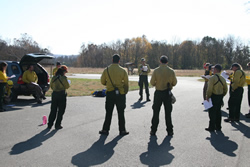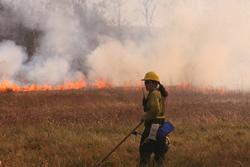
National Fire Plan Success Story
Park Reintroduces Fire
Hopewell Culture National Historical Park, Ohio
National Fire Plan - Rehabilitation
2009

Burn Boss, Scott Beacham, briefs the firefighters before igniting the prescribed fire.

Biologist Dafna Reiner observes fire behavior as it burns through a research plot. NPS photo by J. Michael Johnson.
On November 12, west of Chillicothe, Ohio along the banks of the North Fork of Paint Creek, smoke was visible as firefighters conducted a six acre prescribed fire. The area burned was on the south side of Sulphur Lick Road, in the Hopewell Mound Group, part of Hopewell Culture National Historical Park.
“While six acres may not seem like a large area, it represents the first step in reintroducing fire back onto the landscape,” said Hopewell Culture Superintendent Dean Alexander. The primary objectives of this prescribed fire are to reduce the accumulation of hazardous fuels, suppress tree and shrub encroachment, and re-establish the dominance of native plant species.
The Hopewell Mound Group Prairie burn unit is one of several areas in the park that have been considered for the re-introduction of fire. Park Biologist, Dafna Reiner said, “By using fire on portions of the park, we can preserve the biological diversity of the park, in addition to preserving the historical resources.” Many of the archeological areas of the park had been farmed in the past. When the soil is plowed, there is the increased potential to damage archeological resources that may lie near the surface. Now that the National Park Service is managing these areas, farming is no longer practiced, fields are left to fallow, and the native plant species have returned.
Coordinating a burn, no matter what the size is can be quite a challenge in itself. Scott Beacham, Regional Prescribed Fire Specialist, in Omaha, Nebraska explained, “In order to safely conduct a prescribed fire, we need to right combination of resources: engines, ATV’s, and firefighters.” Smaller parks usually do not have sufficient resources to conduct a burn on their own, so ordering resources from other parks and agencies is a standard practice. Beacham, who served as Burn Boss, added, “For this burn we brought in resources from park units within the state, and from other NPS regions. We tried to go with the closest resources, even if they were not from the Midwest Region, where Hopewell [Culture NHP] is located.” In fact, sixteen wildland fire qualified firefighters, participated in this inaugural fire. In addition to the fire qualified staff at Hopewell Culture, assistance came from: Indiana Dunes National Lakeshore; Perry’s Victory and International Peace Memorial; Dayton Aviation Heritage National Historical Park; the Midwest Regional Office Fire Management staff; New River Gorge National River in the Northeast Region; and Cumberland Gap National Historical Park in the Southeast Region. Other agencies participating included the U.S. Fish & Wildlife Service and the Union Township VFD. “We would have liked to have had folks from the Wayne National Forest and the Ohio Department of Natural Resources assist this time, but unfortunately they were burning the same days we wanted to. When you get right weather for your prescription, everybody else in the area is getting the same weather, you are sometimes competing for the same resources,” added Beacham.
In fact, on Thursday one of the engines that came from Indiana Dunes National Lakeshore was headed home when they were dispatched to the Wayne National Forest to assist with a wildland fire on the forest. Days that are good for prescribed fire, are usually the days where wildfire potential is high. Because of this, burn permits and waivers need to be issued before any prescribed fire can be implemented. “Many hours of prep work is done before we can even light the match,” said Beacham. He added, “From the time we lighted our test fire, ‘till the entire unit was burned, it took a total of nineteen minutes.” It took many hours research, planning, and coordination to get that burn completed, but now that the initial planning is done, the next prescribed fire conducted at Hopewell Culture will be easier to plan and easier to implement.
Contact: J. Michael Johnson, Fire Communication and Education Specialist, (402) 661-1760.